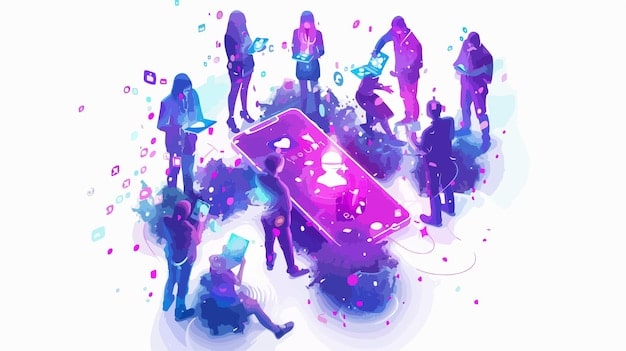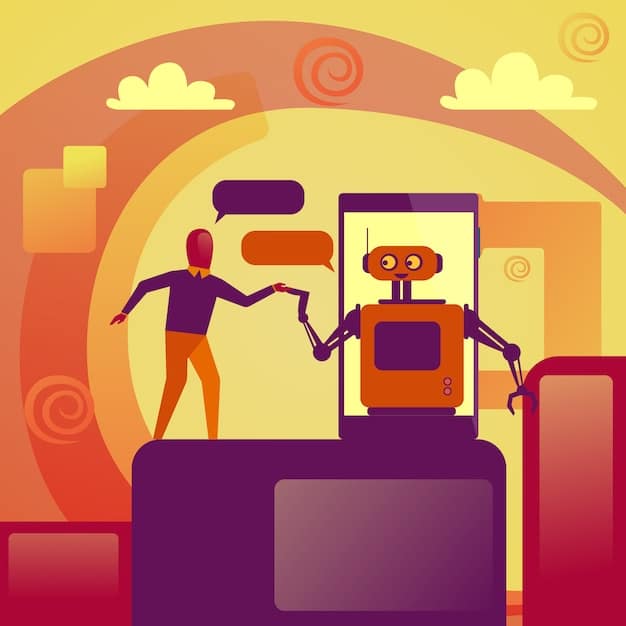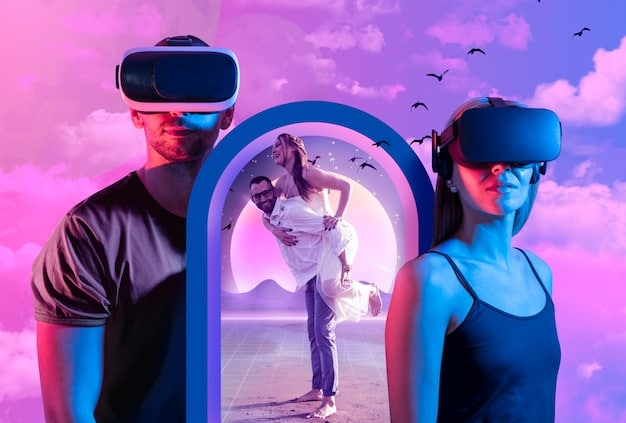Gamification in Online Communities: 2025 Trend Updates

The evolving landscape of online communities in 2025 is increasingly shaped by advanced gamification strategies, leveraging AI-driven personalization, blockchain incentives, extended reality integration, and deeper psychological engagement to foster more dynamic and resilient user participation.
As we advance into 2025, the digital landscape continues to revolutionize how we connect and interact. For those managing and participating in digital spaces, understanding the nuances of how these platforms evolve is crucial. Our focus here delves into the Recent Updates: The Latest Trends in Online Community Gamification for 2025, exploring how innovative approaches are reshaping user engagement and fostering vibrant digital ecosystems.
Understanding the Evolution of Gamification in Digital Spaces
The concept of gamification, applying game-design elements and game principles in non-game contexts, is far from new. However, its application within online communities has seen profound shifts, particularly as we move closer to the mid-2020s. Initially, gamification often amounted to superficial points and leaderboards. Today, the approach is significantly more sophisticated, aiming for deeper psychological resonance and sustained behavioral change.
This evolution is driven by a clearer understanding of human psychology, technological advancements, and the growing demand for more meaningful digital interactions. Community managers are no longer just adding badges; they are designing intricate systems that encourage contribution, learning, and genuine connection, transforming passive lurkers into active participants.
From Basic Badges to Meaningful Motivators
Early gamification attempts often struggled because they failed to connect with intrinsic motivations. Users might collect points for a while, but without a deeper purpose, retention remained a challenge. The focus has decisively shifted towards aligning gamified elements with users’ core needs and desires.
- Status and Recognition: Beyond simple leaderboards, systems now offer nuanced displays of expertise and contribution, providing genuine social capital within the community.
- Achievement and Mastery: Progressive challenges and learning pathways allow users to develop skills, fostering a sense of accomplishment.
- Purpose and Affiliation: Gamified activities that contribute to a collective goal or strengthen group identity resonate deeply with users’ need for belonging.
- Autonomy and Control: Empowering users with choices over their engagement pathways and rewards can significantly boost participation.
The goal is to cultivate an environment where engagement feels less like a chore and more like a naturally rewarding activity. This requires a profound understanding of the community’s specific dynamics and the motivations of its members, moving beyond a one-size-fits-all model prevalent in earlier iterations of gamification.
Ultimately, the success of gamification now hinges on its ability to seamlessly integrate with the core purpose of the online community, enhancing rather than distracting from its primary value proposition. It’s about building a sustainable ecosystem where playful elements facilitate, rather than dictate, meaningful interaction and participation.
AI-Driven Personalization: Tailoring the Gamified Experience
One of the most transformative trends in online community gamification for 2025 is the pervasive integration of Artificial Intelligence (AI) to personalize the user experience. Gone are the days of generic challenges and universal reward systems; AI allows for dynamic adaptation of gamified elements to individual user behaviors, preferences, and progress. This leads to significantly higher engagement and more relevant interactions for each community member.
AI algorithms analyze vast amounts of user data, including participation history, content consumption, interaction patterns, and even sentiment analysis of contributions. With these insights, communities can offer hyper-targeted quests, personalized recognition, and adaptive progression paths that genuinely resonate with each individual. This shift makes the gamified journey feel much more bespoke and inherently rewarding, as it directly addresses what motivates each unique user.
Adaptive Challenges and Intelligent Nudging
AI’s role in creating adaptive challenges marks a significant leap. Instead of a fixed ladder of achievements, AI can dynamically adjust the difficulty and type of challenge presented to a user based on their current skill level and engagement trajectory. This ensures that tasks are neither too easy (leading to boredom) nor too hard (leading to frustration), maintaining an optimal flow state.
- Skill-Based Progression: AI identifies a user’s proficiency in specific areas (e.g., content creation, moderation, problem-solving) and offers challenges that build upon those strengths or address weaknesses.
- Predictive Engagement: Algorithms can predict when a user’s engagement might wane and proactively offer timely, personalized nudges or new opportunities to re-engage.
- Content Recommendation for Quests: AI can suggest specific content to engage with or create, turning content consumption or contribution into a gamified quest tailored to individual interests.
Beyond individual experiences, AI can also analyze group dynamics to suggest collaborative challenges that foster teamwork and collective achievement. By understanding who works well together or who might benefit from interaction, AI can facilitate organic connections within the community through gamified group activities.
The intelligence extends to recognizing different user archetypes within the community—whether they are “explorers,” “achievers,” “socializers,” or “killers” (in Bartle’s taxonomy)—and tailoring interventions or reward structures to match their inherent play styles. This level of granularity ensures that gamification becomes a true personal assistant for engagement, rather than a blunt instrument.

The net effect of AI-driven personalization is a community environment that feels alive and responsive, constantly adapting to meet the evolving needs of its members. This sophisticated approach moves gamification beyond a mere feature and establishes it as a core, intelligent layer of the community experience.
Blockchain and NFTs: Enabling True Ownership and Decentralized Rewards
The advent of blockchain technology and Non-Fungible Tokens (NFTs) is injecting a revolutionary dimension into online community gamification for 2025. These technologies address a longstanding challenge in digital environments: the lack of true ownership over earned assets and the centralization of reward systems. By leveraging blockchain, communities can now offer verifiable, scarce, and truly tradable digital assets as gamified rewards, empowering users in unprecedented ways.
NFTs, in particular, serve as unique digital certificates of ownership, making them ideal for representing exclusive badges, rare items, unique avatars, or even fractional ownership in community intellectual property. This move from ephemeral in-platform points to tangible, blockchain-secured assets transforms the incentive structure, providing real-world value and a greater sense of investment for community members. Users now have immutable proof of their achievements and contributions, fostering a deeper sense of pride and belonging.
From Centralized Points to Decentralized Economies
Traditional gamification relied on centralized systems where platform administrators controlled all points and rewards. Blockchain introduces decentralization, allowing for transparent, auditable, and immutable records of achievements and a more equitable distribution of rewards. This fundamental shift aligns with the growing desire for user empowerment and transparency in digital spaces.
- Verifiable Achievements: NFTs can represent earned achievements (e.g., “Top Contributor NFT,” “Community Moderator Badge”) that are verifiable on the blockchain, extending their value beyond the confines of a single platform.
- Tradable Rewards: Gamified items, badges, or even virtual currency earned can be issued as NFTs or tokens, allowing users to trade, sell, or collect them, creating a vibrant secondary market.
- Community Governance and DAO Integration: In some advanced models, earned tokens or NFTs could grant voting rights in Decentralized Autonomous Organizations (DAOs) that govern the community, giving users a direct say in its future development.
This paradigm shift creates a new economic layer within online communities. Members are no longer just consumers of content or participants in activities; they become stakeholders with a direct, vested interest in the community’s success, as their accumulated value (via NFTs or tokens) is inextricably linked to it. This cultivates a stronger sense of loyalty and a more robust, self-sustaining ecosystem.
The transparency and trust inherent in blockchain technology further enhance the perceived fairness of gamified systems. Users can see precisely how rewards are distributed and verified, reducing suspicion and fostering greater confidence in the system. As the broader digital economy increasingly embraces decentralized principles, online communities that smartly integrate blockchain and NFTs will be at the forefront of the next wave of engagement.
Extended Reality (XR) Integration: Immersive Gamified Worlds
As we push deeper into 2025, the integration of Extended Reality (XR)—encompassing Virtual Reality (VR), Augmented Reality (AR), and Mixed Reality (MR)—is poised to transform online community gamification into profoundly immersive and interactive experiences. XR transcends the flat screen, allowing users to inhabit and interact with gamified elements in three-dimensional, spatial environments. This creates a much richer sensory experience that can significantly deepen engagement and foster stronger connections.
Imagine navigating a community space not as a webpage, but as a virtual world where your contributions are represented by tangible structures, your achievements by glowing trophies, and collaborative quests unfold in real-time within a shared virtual landscape. XR moves gamification from a cognitive exercise to an experiential one, tapping into spatial memory and kinesthetic learning to create memorable and highly motivating interactions. It allows for a level of presence and immersion that traditional interfaces simply cannot match. Platforms are leveraging this to create more dynamic environments where every interaction feels more meaningful and less abstract.
Gamified Avatars and Spatial Challenges
In XR-enabled communities, user avatars become more than just profile pictures; they are extensions of self within the virtual space, capable of displaying gamified achievements like holographic badges, custom outfits earned through quests, or even unique particle effects that signify status. The gamification is literally embodied by the user’s presence in the world.
- Spatial Questlines: Quests can involve navigating virtual environments, solving spatial puzzles collaboratively, or interacting with gamified non-player characters (NPCs) to complete challenges.
- Augmented Reality Overlays: AR can overlay gamified elements onto the real world—imagine earning “community points” by scanning physical objects related to community topics or collaborating on AR-based creative projects.
- Interactive Virtual Events: Gamified events, such as virtual scavenger hunts, escape rooms, or collaborative building challenges, become fully immersive experiences within the community’s metaverse.

The sensory richness of XR allows for completely new forms of gamified feedback. Visual cues, spatial audio, and even haptic feedback can communicate progress, achievement, or prompts for engagement in novel ways. This multi-modal feedback creates a more profound sense of accomplishment and immediate reward, tying actions directly to tangible, albeit virtual, outcomes.
Crucially, XR fosters a deeper sense of social presence. Interacting with other community members’ avatars in a shared virtual space can feel more akin to a real-world social gathering, strengthening bonds and making collaborative gamified activities intrinsically more rewarding. This shift signifies a move towards truly living within our online communities, where gamification becomes an integral part of our spatial and social experiences.
Psychological Design Principles: Beyond Extrinsic Rewards
As gamification matures, a critical evolution in 2025 is the deepened understanding and application of psychological design principles, moving beyond mere extrinsic rewards (points, badges) to tap into intrinsic motivators. This shift acknowledges that sustainable engagement stems from activities that are inherently enjoyable, meaningful, and satisfying. Successful gamification now meticulously integrates theories from behavioral economics, cognitive psychology, and flow state research to design systems that genuinely resonate with human nature.
The goal is to foster a sense of autonomy, competence, and relatedness within the community. When users feel they have control over their actions, are progressing and mastering skills, and are connected to others, their engagement becomes self-sustaining. This nuanced approach differentiates between short-term novelty and long-term behavioral change, prioritizing the latter by designing for intrinsic satisfaction rather than just external incentives. It’s about crafting an experience where the act of participating is its own reward, enhanced by thoughtful gamified elements.
Leveraging Behavioral Economics and Cognitive Biases
Sophisticated gamification designs now subtly leverage well-documented cognitive biases and principles from behavioral economics to encourage desired behaviors. This isn’t about manipulation, but about gently guiding users towards engagement that benefits both them and the community.
- Loss Aversion: Framing challenges to highlight what might be lost by not participating (e.g., missing out on a unique badge or collaborative progress) can be a powerful motivator.
- Endowed Progress Effect: Providing users with a small initial “head start” on a progress bar or quest can significantly increase their likelihood of completing the task.
- Sunk Cost Fallacy: As users invest time and effort into a gamified system, their commitment increases, making them more likely to continue engaging.
- Social Proof and Reciprocity: Highlighting the achievements of others or showcasing collective effort can encourage participation through social comparison and the desire to contribute back to the community.
Furthermore, designers are paying much closer attention to concepts like ‘scarcity’ and ‘exclusivity’ in virtual rewards, understanding that perceived rarity often makes an item more desirable. This doesn’t mean making everything unobtainable, but rather creating thoughtful tiers of rewards that maintain their appeal without resorting to excessive grinding or ‘pay-to-win’ mechanics.
The careful balance lies in creating challenging yet achievable goals, providing clear and immediate feedback, and fostering a sense of continuous improvement. When gamified elements are aligned with these psychological principles, they act as powerful catalysts for deeper, more meaningful engagement, transforming community experiences from passive consumption to active, intrinsically motivated participation.
From Community Engagement to Collective Impact: Gamification with Purpose
In 2025, online community gamification is increasingly moving beyond individual achievements to encompass and incentivize collective impact and purpose-driven activities. This trend reflects a broader societal shift towards values-driven participation, where users seek to contribute to something larger than themselves. Gamification is now being strategically designed to rally community members around shared goals, fostering collaboration on projects that have real-world or significant in-community benefits.
This approach moves the focus from personal leaderboards to collaborative missions, encouraging users to leverage their diverse skills and knowledge for a common good. It transforms the community from a passive forum into an active collective, where gamified elements facilitate the coordination and execution of meaningful projects. Whether it’s contributing to open-source knowledge bases, solving complex problems, or even engaging in social good initiatives, gamification is becoming a powerful tool for mobilizing collective action and demonstrating tangible community value.
Crowdsourced Innovation and Collaborative Quests
Gamification is proving particularly effective in stimulating crowdsourced innovation and problem-solving within online communities. By framing complex tasks as collaborative quests or challenges, communities can tap into the collective intelligence of their members, often yielding solutions that would be unattainable by individuals alone.
- Knowledge Building Quests: Gamified tasks that encourage users to contribute to and curate a community’s knowledge base, e.g., writing articles, answering questions, or fact-checking content.
- Problem-Solving Challenges: Communities pose real-world or theoretical problems, and members collaborate to find solutions, earning collective rewards for breakthroughs.
- Social Good Initiatives: Gamified challenges that encourage members to participate in charitable activities, environmental efforts, or social advocacy campaigns, with shared progress tracking.
- Content Co-creation: Facilitating the collaborative creation of new content, art, or resources, where each member’s contribution is recognized and celebrated through gamified milestones.
The introduction of collective progress indicators, shared leaderboards for teams, and ‘guild’ or ‘clan’ systems further strengthens this shift towards communal impact. Users are not just earning points for themselves, but for their team or the community as a whole, fostering a strong sense of solidarity and shared responsibility. The rewards often include collective recognition, access to exclusive community resources, or even direct contribution to the community’s future direction.
This trend highlights the immense potential of gamification to transform online communities into powerful engines of collective creation and positive change. By aligning individual motivations with broader community objectives, gamification helps to unlock unparalleled levels of sustained, meaningful participation, proving that play can indeed lead to profound purpose.
The Future Landscape: Sustainable Engagement Strategies
Looking further into 2025 and beyond, the evolution of online community gamification is increasingly focused on developing sustainable engagement strategies that prevent burnout, adapt to changing user needs, and foster long-term vibrancy. Early gamification efforts often suffered from novelty fatigue, where initial excitement faded as users exhausted the available challenges or found the rewards uninspiring. The future demands systems that are dynamic, self-renewing, and intrinsically fulfilling, designed to evolve alongside the community itself.
This involves a transition from fixed gamified paths to more open-ended, adaptive systems that emphasize journey over destination. It means incorporating elements of procedural generation for new content, user-generated gamified experiences, and robust feedback loops that allow the community to influence its own gamified evolution. The goal is to create a living, breathing gamified ecosystem that maintains its appeal year after year, avoiding the pitfalls of static design. It’s about building a robust framework that supports continuous innovation and remains fresh and relevant for its members.
Preventing Fatigue and Fostering Longevity
A key challenge for sustainable gamification is preventing user fatigue. This is addressed through several strategic approaches:
- Seasonal Challenges and Events: Regularly introducing new, time-limited gamified events or “seasons” keeps engagement fresh and provides opportunities for re-engagement.
- Modularity and Customization: Allowing communities or even individual users to customize or create their own gamified modules fosters a sense of ownership and endless variety.
- Emphasis on Intrinsic Rewards: Continuously reinforcing the inherently satisfying aspects of community participation (connection, learning, contribution) helps users stay engaged even when extrinsic rewards are less frequent.
- Anti-Grinding Mechanics: Designing systems that dissuade excessive, repetitive behavior and instead reward diverse forms of participation prevents “grinding” burnout.
Furthermore, communities are investing in advanced analytics not just to track engagement, but to proactively identify potential drop-off points or signs of disengagement within the gamified system. This allows for timely interventions, such as personalized re-engagement campaigns or adjustments to the gamification mechanics themselves, ensuring that the system remains responsive to the community’s health.
The ultimate vision for sustainable gamification is a self-optimizing, community-driven system where the gamified elements are so seamlessly integrated that they feel like a natural extension of the community’s identity and purpose. This long-term perspective ensures that online communities don’t just briefly capture attention, but actively cultivate lasting belonging and continuous, meaningful interaction.
| Key Trend | Brief Description |
|---|---|
| 🤖 AI-Driven Personalization | Tailoring gamified experiences to individual user behaviors and preferences for deeper engagement. |
| 🔗 Blockchain & NFTs | Enabling true ownership of digital assets and decentralized, verifiable rewards for contributions. |
| 🌌 XR Integration | Creating immersive virtual and augmented reality experiences for gamified interactions. |
| 🎯 Collective Impact | Gamifying to foster collaboration on shared goals and purpose-driven community projects. |
Frequently Asked Questions about Gamification Trends
▼
The main benefit of AI in 2025 gamification is hyper-personalization. AI analyzes user data to provide tailored challenges, rewards, and engagement pathways, making the experience more relevant and motivating for each individual. This adaptability significantly boosts sustained participation and satisfaction within online communities.
▼
NFTs revolutionize gamified rewards by enabling true digital ownership and tradability. Unlike conventional points or badges, NFTs are unique, verifiable, and scarce assets on the blockchain. This provides real-world value to in-community achievements, fostering a deeper sense of investment, pride, and potential for secondary markets for earned items.
▼
XR integration is crucial because it offers immersive, three-dimensional experiences that go beyond traditional flat interfaces. It allows for spatial quests, embodied avatars, and interactive virtual events, turning abstract gamified elements into tangible, engaging experiences. This heightened immersion fosters stronger social presence and deeper, more memorable interactions within communities.
▼
“Psychological design principles” refer to applying insights from behavioral economics and cognitive psychology to gamification. This means designing systems that tap into intrinsic human motivations like autonomy, competence, and relatedness, rather than solely relying on extrinsic rewards. The goal is to make engagement inherently satisfying, promoting long-term, self-sustaining participation.
▼
Gamification is promoting collective impact by shifting focus from individual achievements to shared goals and purpose-driven activities. It designs collaborative quests, challenges for crowdsourced innovation, and initiatives for social good. This fosters teamwork, leverages collective intelligence, and empowers communities to achieve tangible outcomes, turning them into active engines of positive change.
Conclusion
The landscape of online community gamification in 2025 is characterized by a significant evolution from simplistic reward systems to sophisticated, psychologically informed, and technologically advanced strategies. The integration of AI for hyper-personalization, blockchain for true ownership and decentralized incentives, and XR for immersive experiences are fundamentally reshaping how users engage. Furthermore, a renewed focus on psychological design principles for intrinsic motivation and the pivot towards collective, purpose-driven impact are fostering deeper, more sustainable community vibrancy. As these trends mature, gamification moves beyond a mere feature, becoming an integral, dynamic layer that cultivates thriving, resilient, and truly impactful online communities.





